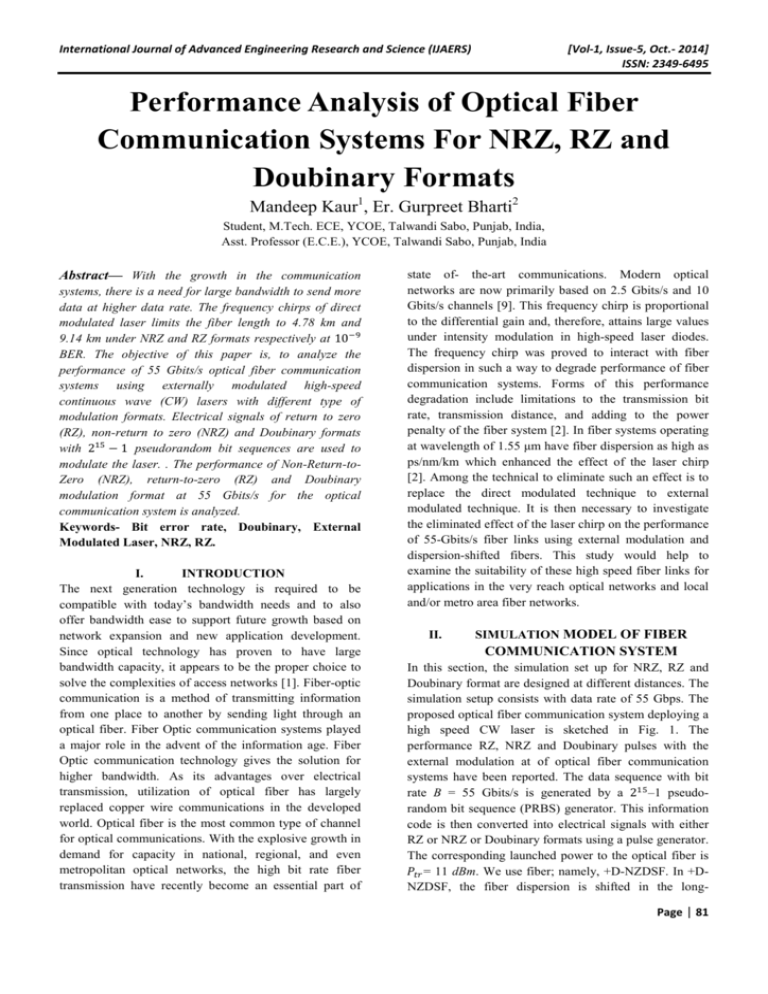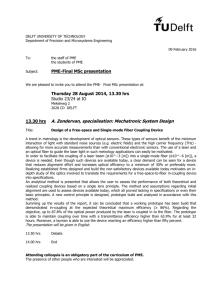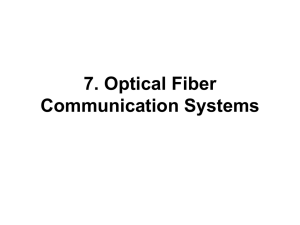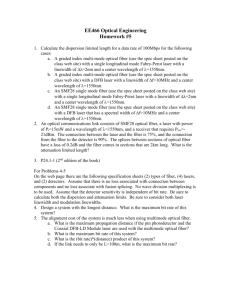Performance Analysis of Optical Fiber Communication
advertisement

International Journal of Advanced Engineering Research and Science (IJAERS) [Vol-1, Issue-5, Oct.- 2014] ISSN: 2349-6495 Performance Analysis of Optical Fiber Communication Systems For NRZ, RZ and Doubinary Formats Mandeep Kaur1, Er. Gurpreet Bharti2 Student, M.Tech. ECE, YCOE, Talwandi Sabo, Punjab, India, Asst. Professor (E.C.E.), YCOE, Talwandi Sabo, Punjab, India Abstract— With the growth in the communication systems, there is a need for large bandwidth to send more data at higher data rate. The frequency chirps of direct modulated laser limits the fiber length to 4.78 km and 9.14 km under NRZ and RZ formats respectively at 10 BER. The objective of this paper is, to analyze the performance of 55 Gbits/s optical fiber communication systems using externally modulated high-speed continuous wave (CW) lasers with different type of modulation formats. Electrical signals of return to zero (RZ), non-return to zero (NRZ) and Doubinary formats with 2 − 1 pseudorandom bit sequences are used to modulate the laser. . The performance of Non-Return-toZero (NRZ), return-to-zero (RZ) and Doubinary modulation format at 55 Gbits/s for the optical communication system is analyzed. Keywords- Bit error rate, Doubinary, External Modulated Laser, NRZ, RZ. I. INTRODUCTION The next generation technology is required to be compatible with today’s bandwidth needs and to also offer bandwidth ease to support future growth based on network expansion and new application development. Since optical technology has proven to have large bandwidth capacity, it appears to be the proper choice to solve the complexities of access networks [1]. Fiber-optic communication is a method of transmitting information from one place to another by sending light through an optical fiber. Fiber Optic communication systems played a major role in the advent of the information age. Fiber Optic communication technology gives the solution for higher bandwidth. As its advantages over electrical transmission, utilization of optical fiber has largely replaced copper wire communications in the developed world. Optical fiber is the most common type of channel for optical communications. With the explosive growth in demand for capacity in national, regional, and even metropolitan optical networks, the high bit rate fiber transmission have recently become an essential part of state of- the-art communications. Modern optical networks are now primarily based on 2.5 Gbits/s and 10 Gbits/s channels [9]. This frequency chirp is proportional to the differential gain and, therefore, attains large values under intensity modulation in high-speed laser diodes. The frequency chirp was proved to interact with fiber dispersion in such a way to degrade performance of fiber communication systems. Forms of this performance degradation include limitations to the transmission bit rate, transmission distance, and adding to the power penalty of the fiber system [2]. In fiber systems operating at wavelength of 1.55 µm have fiber dispersion as high as ps/nm/km which enhanced the effect of the laser chirp [2]. Among the technical to eliminate such an effect is to replace the direct modulated technique to external modulated technique. It is then necessary to investigate the eliminated effect of the laser chirp on the performance of 55-Gbits/s fiber links using external modulation and dispersion-shifted fibers. This study would help to examine the suitability of these high speed fiber links for applications in the very reach optical networks and local and/or metro area fiber networks. II. SIMULATION MODEL OF FIBER COMMUNICATION SYSTEM In this section, the simulation set up for NRZ, RZ and Doubinary format are designed at different distances. The simulation setup consists with data rate of 55 Gbps. The proposed optical fiber communication system deploying a high speed CW laser is sketched in Fig. 1. The performance RZ, NRZ and Doubinary pulses with the external modulation at of optical fiber communication systems have been reported. The data sequence with bit rate B = 55 Gbits/s is generated by a 2 –1 pseudorandom bit sequence (PRBS) generator. This information code is then converted into electrical signals with either RZ or NRZ or Doubinary formats using a pulse generator. The corresponding launched power to the optical fiber is = 11 dBm. We use fiber; namely, +D-NZDSF. In +DNZDSF, the fiber dispersion is shifted in the longPage | 81 International Journal of Advanced Engineering Research and Science (IJAERS) wavelength side to 4.5 ps/nm/km and the fiber slope decreases to 0.01 ps/nm2/km. The attenuation coefficient has value 0.18 dB/km. The data sequence with bit rate is generated by a pseudo-random bit sequence (PRBS) generator. This information code is then converted into electrical signals with either RZ or NRZ or Doubinary formats using a pulse generator. In the laser driver model, the bias and modulation currents are combined (external modulation), and the output current waveform is recorded. The laser signal is transmitted down a +DNZSDF. The laser signal is detected and converted into an electrical signal by a PIN photo detector. The transmission information is then retrieved and the corresponding errors in identification of the “1” and “0” bits are evaluated in terms of BER. The high-speed fiber system is designed and simulated by the OptiSystem software. Fig.1 Block diagram of the designed optical fiber communication system. A. External Modulation External modulation, where the laser is always on and a subsequent optical modulator is used to modulate the laser light with the electrical signal. An external modulator controls the light functioning like an electrically activated shutter. While analog devices, external modulators allow the amount of light passed to vary from some maximum amount (PMAX) to some minimum amount (PMIN). The external modulator uses a constant laser source also referred to as a continuous wave laser (CW laser). The MZM is inserted between the CW Laser and the fiber link to create the desired transmitter. In the MZM the CW light is split equally into two parallel waveguides on the surface of the substrate, usually LiNbO3 and then recombined at the output. [Vol-1, Issue-5, Oct.- 2014] ISSN: 2349-6495 In this subsection, we characterize and evaluate performance of the proposed 55Gbits/s optical fiber communication system. The performance evaluation parameters include the eye diagram of the detected signal, BER and dispersion-limited fiber length. Fig.2 shows the eye diagrams for NRZ, RZ and Doubinary formats corresponds to BER 10 . 3.1 NRZ Modulation format Non return to zero line is a binary code in which one’s (1’s) are represented as a positive voltage (+v) and zero’s (0’s) are represented as a negative voltage (-v). NRZ codes use half the baseband bandwidth. The intensity of the carrier light wave is modulated by the applied electric field in which voltage varies with a determined function. The fiber length is varied over an open range. On each fiber length, the laser signal is detected and BER is evaluated by BER Analyzer. Then decided the fiber length 12.09 km at which BER is equal to10 . Fig. 1(a) shows eye diagram of NRZ at 12.09 km with BER 10 . 3.2 RZ Modulation format It consist Return to Zero (RZ) pulse generator with duty cycle 0.5 (50%), CW laser, +D-NZDSF, Attenuator, Photodetector pin diode and Low pass Bessel filter. External modulation use Mach Zehnder external modulator to modulate the CW Laser and RZ electrical signal. The fiber length is varied over an open range. On each fiber length, the laser signal is detected and BER is evaluated by BER Analyzer. Then decided the fiber length at which BER is equal to10 . Fig. 1(b) shows eye diagram of NRZ at 13.23 km with BER 10 . 3.3 Doubinary Modulation format In Doubinary format, Phase shifted by π after odd number of zeros. In this DB scheme using less than N/2 Hz of bandwidth to transmit N bits/s. DB gives high dispersion tolerance and narrow band optical filtering, these are the main advantages of using. Conventional DB transmitters apply a differential precoder at the input. BER analyzer is represents the output characteristics of applied Doubinary modulation format with external modulation at the different distances. Fig.1(c) shows eye diagram of the Doubinary-modulated signal at 20.20 km value of fiber length at the boundary of BER=10 . III. RESULTS AND DISCUSSIONS A. Performance parameters of the fiber system Page | 82 International Journal of Advanced Engineering Research and Science (IJAERS) [Vol-1, Issue-5, Oct.- 2014] ISSN: 2349-6495 IV. CONCLUSION We simulated the optical fiber communication systems under 55Gbits/s modulation and quantified its performance. The system performance is evaluated in terms of eye diagram, BER, receiver sensitivity, and limitations on the fiber length. Inside optical fiber communication system, Doubinary modulation provides better results as compared to NRZ and RZ modulation format. Distance is the crucial factor for measuring the system performance at BER=10 . The fiber lengths are increase to 12.09 km for NRZ, 13.23 km for RZ and 20.2 km for Doubinary with limits BER= 10 , when the direct modulation is replaced by external modulation technique. Hence from these results it has been concluded that in terms of length for Doubinary modulation format is more as compare to RZ and NRZ modulation formats, it can be used for long distance transmission. So this work is further extended with the use of advanced modulation formats. We can also vary the data rate and length of fiber with applying dispersion compensation techniques. (a) (b) (c) Fig.2 the simulated eye diagrams under (a) NRZ (b) RZ and (c) Doubinary modulation formats. The maximum fiber length corresponds to BER =10 . REFERENCES [1] A. Kapoor et al,“ Performance Comparison of Modulation Formats for Wavelength Re-modulated Bi-directional Passive Optical Network”, International Journal of Engineering, Business and Enterprise Applications, 5(2), June-August, 2013, pp. 169-172 [2] Fwoziah T. Albeladi, Moustafa F. Ahmed and Ahmed H. Bakry, “Performance Evaluation of 40Gb/s Directly-Modulated Optical Fiber Communication Systems”, 978-1-4673-61958/13/$31.00 ©2013 IEEE [3] G.P. Agarwal, ‘Fiber-Optic Communication Systems’ John Wiley and Sons, New York, (2002) [4] Peter J. Winzer, “Advanced Optical Modulation Formats” Vol. 94, No. 5, May 2006 ,00189219/$20.00 _2006 IEEE [5] P.Krehlik, “Directly modulated laser in negative dispersion fiber link”, Opto-Electron. Rev. 15, no. 2, 2007 [6] Ramandeep Kaur, Dr. R. S. Kaler, “Performance Analysis of Hybrid Optical Amplifiers for multichannel WDM systems”, Department of Electronics and Communication Engineering Thapar University June-2011 [7] Shashi Jawla ‘intensity modulation formats in optical communication system’ International Journal of Scientific & Engineering Research, Volume 4, Issue 12, December-2013. [8] Shashi Jawla, R.K.Singh, “Different Modulation Page | 83 International Journal of Advanced Engineering Research and Science (IJAERS) [Vol-1, Issue-5, Oct.- 2014] ISSN: 2349-6495 Formats Used In Optical Communication System”, IOSR Journal of Electronics and Communication Engineering e-ISSN: 2278-2834, p- ISSN: 22788735.Volume 8, Issue 4, Nov. - Dec. 2013 [9] Varun Marwaha et al., “Performance Evaluation of Modulation Format for Optical System”, International Journal of Electronics & Communication Technology, Vol. 3, Issue 1, Jan. March,2012 Page | 84








